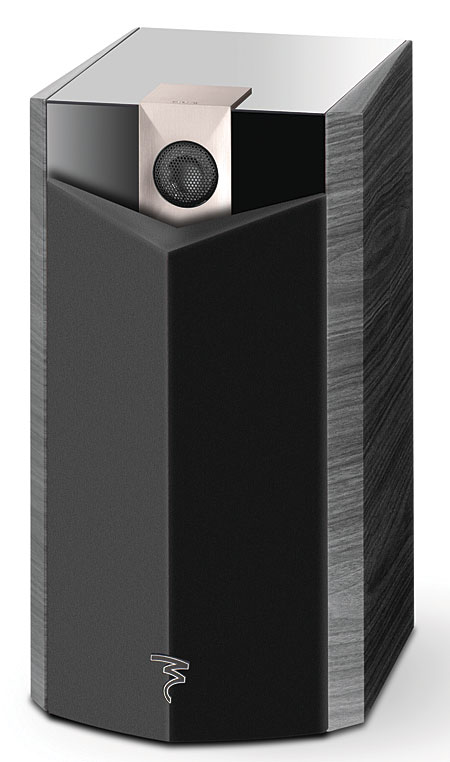| Columns Retired Columns & Blogs |
Focal Chorus 807V loudspeaker Page 2
Playing recordings of bombastic orchestral works, I was very impressed with the Chorus 807V's lower bass range. From the timpani passage in the first movement of David Chesky's Violin Concerto, from his Area 31 collection (SACD/CD, Chesky SACD 288), to the bass drum in the finale of Stravinsky's The Firebird in the recording by Antal Dorati and the London Symphony (CD, Mercury Living Presence SR90226), I felt I was listening to larger, more dynamic floorstanders. I had the same reaction to the opening tracks of Kraftwerk's Minimum/Maximum (CD, EMI ASW 60611)—when cranked to rock-concert levels, they shook the room without compression, distortion, or strain.
But to really appreciate this ruthlessly revealing speaker, I had to trot out the highest-quality recordings I had. Then I was rewarded with staggering realism for the price. Timothy Seelig and the Turtle Creek Chorale's recording of John Rutter's Requiem (CD, Reference RR-57CD) bloomed with richly layered vocals, and a sense of ease and naturalness around the organ. The pedal notes were natural-sounding and seemed quite extended (how low do these puppies go, JA?), but never seemed overpowering or in my face.

I've played Kohjiba's Transmigration of the Soul, from the Santa Fe Chamber Music Festival's Festival (CD, Stereophile STPH007-2), many times, but with the Chorus 807V I was struck by the upper partials of Carol Wincenc's flute—I had never before heard this recording with so much air. Cellist Peter Wyrick's bowed attacks had much more power, finesse, and articulation than I'd noticed before, and Tyler Mack's timpani reverberated off the surfaces of the St. Francis Auditorium before naturally decaying. However, the loudest thwacks in the marimba's upper register were more prominent than I'd remembered.
I've spent a long time listening to Live at Merkin Hall, John Atkinson's recording of my jazz quartet, Attention Screen (CD, Stereophile STPH018-2). However, the Chorus 807V was the first speaker to let me completely warm up to this recording and analyze our performance—it sounded as if I'd been transported back to the Merkin's stage. The mid-1990s Steinway D piano I played that day was as good as any instrument I've ever played (so much for the theory that new Steinways aren't as good as older ones), but only with the Focal did the opening piano passage of "Mansour's Gift" sound exactly as that piano had sounded that day in February. The more I play with drummer Mark Flynn, the more I am in awe of his technique, passion, versatility, and economy. Listening to the simple funk backbeat he lays down at the beginning of "Blizzard Limbs," I found myself staring at the dynamic articulation of his simple, wet-sounding bass-drum foundation and his carefully placed snare shots. Through the Chorus 807V, his cymbals sounded as natural as when I've heard him live.
Comparing
I compared the Focal Chorus 807V ($995) with the Nola Mini ($695 when available), the Amphion Helium2 ($1000), and the Monitor Audio Silver RS6 ($1000). (All speaker prices are per pair.)
The midrange performances of all four speakers were in the same league with respect to lack of coloration, resolution of detail, and organic low-level dynamic articulation. The main differences among these speakers lay in their high-frequency presentation, bass extension, and high-level dynamic performance. The Nola Mini had considerable high-frequency detail but was not as extended as the Chorus 807V and seemed a bit more relaxed in that region. The Nola's bass extension was comparable to the Focal's, but the latter had superior high-level dynamic slam.
The Amphion Helium2 also had quite extended highs that were pure and detailed, but its extreme top seemed a bit softer and more pillowy, a characteristic I find appealing with all recordings. The Helium2's low-frequency extension and high-level dynamics weren't even close to the Chorus 807V's, however.
Finally, the Monitor Silver RS6's highs seemed almost as extended as the Focal's, but the RS6 was a bit more forgiving at the extreme top end. The floor-standing Monitor's bass extension and high-level dynamic performance, however, were by far the strongest of the group.
Concluding
The Focal Chorus 807V is an attractive and revealing loudspeaker of very low coloration and high versatility that gave me hours of enjoyment with a wide range of program material. I also feel that, at $995/pair, it is a superb value for the money. However, its tweeter is so extended in range and consequently so revealing that careful matching with other components and recordings is warranted. With the finest associated gear and recordings, the Chorus 807V achieved a level of performance that competed with much more expensive speakers. I commend Focal for trickling down the technology of their more expensive wares to such an affordable realm.
- Log in or register to post comments




































